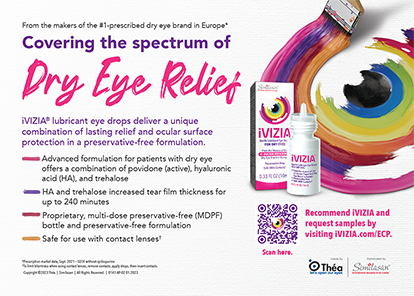
The incidence of retained lens fragments after phacoemulsification is reported to be less than 1%. This complication, however, is clinically relevant. During phacoemulsification, lens pieces may remain in the anterior chamber angle, behind the iris, or in the vitreous cavity in the event a posterior capsular rupture occurred.1
1. RISK FACTORS
Some characteristics that are generally encountered in patients presenting with retained lens fragments after uneventful cataract surgery include high myopia with long axial length, steep cornea, shallow anterior chamber depth, dense cataract (grade 3+), light iris pigmentation, small pupil, and dense peripheral arcus senilis that can result in loss of contrast between the iris and the lens.2
Surgical technique, laser fragmentation with a grid pattern, and surgeon operative load have also been proposed but not proven conclusively as risk factors.2 Complications are most commonly seen when there is a compromised posterior capsule or weak zonules before the lens is completely extracted.
2. CLINICAL SIGNS
Varying degrees of intraocular inflammation, elevated IOP, and corneal edema (particularly inferior sectoral) are the most commonly reported symptoms and causes of visual loss associated with retained lens fragments. Retained cortical material is usually better tolerated than are nuclear fragments. The size and density of the retained material, however, correlates to the severity of the symptoms. Cystoid macular edema and chronic glaucoma can also develop if treatment of retained lens fragments is delayed.3
A tiny piece of the lens can be found in the anterior chamber months or even years after surgery.4 A serious complication such as a retinal tear or detachment is relatively uncommon but has been reported in patients with complicated cataract surgery. In these cases, an additional pars plana vitrectomy may be required for lens extraction.5
3. DIAGNOSIS
The majority of retained lens fragments can be observed with a slit-lamp examination of the inferior angle of the anterior chamber or with a dilated fundus examination of the vitreous cavity. When lens fragments are sequestered in the ciliary sulcus, however, ultrasound biomicroscopy is required for detection. Gonioscopy can also be helpful in these cases, especially when wedge corneal edema is present because it can obstruct direct visualization. Additionally, persistent corneal edema and intraocular inflammation after cataract surgery merit a detailed examination and raise the level of suspicion of retained fragments.
4. MANAGEMENT
Topical steroids to decrease inflammation and glaucoma drops to control IOP are effective initial treatments.6 Most cases involve an intact posterior capsule. Unresponsive intraocular inflammation, uncontrolled IOP elevation, and large and retained nuclear fragments are typically refractory to topical medication. Depending on the location of the fragments, such cases may require anterior or posterior segment surgery for extraction.
5. CONTROVERSIES
Pars plana vitrectomy improves visual acuity and IOP elevation in eyes with retained nuclear fragments in the posterior segment. The ideal timing of the surgery is still debated. Some argue that delaying the pars plana vitrectomy for a few weeks is beneficial because it improves corneal edema and visualization.6 Most recent studies show that clinical outcomes were similar in patients undergoing early and late (7–14 days) vitrectomy.5 Cystoid macular edema and uncontrolled glaucoma are more likely to occur when vitrectomy is delayed for more than 21 days.
CONCLUSION
Retained lens fragments are statistically unlikely after cataract surgery but can be clinically relevant. They are associated with significantly poorer visual outcomes than with uncomplicated cataract surgery. Worse final visual acuity is observed in patients with retained lens fragments who had complicated cataract surgery with posterior capsular rupture, retinal detachment, or associated ocular comorbidity.
1. Mahr MA, Lum, F, Fujino D, Kelly SP, Erie JC. Return to the operating room for removal of retained lens fragments after cataract surgery: IRIS registry (intelligent research in sight) analysis. Ophthalmology. 2020;127(5):698-699.
2. Norton JC, Goyal S. Patient characteristics and outcomes of retained lens fragments in the anterior chamber after uneventful phacoemulsification. J Cataract Refract Surg. 2018;44(7):848-855.
3. Vilar NF, Flynn HW, Smiddy WE, Murray TG, Davis JL, Rubsamen PE. Removal of retained lens fragments after phacoemulsification reverses secondary glaucoma and restores visual acuity. Ophthalmology. 1997;104(5):787-792.
4. Nair M, Pandit RT. Retained lens nuclear fragment presenting years after phacoemulsification. J Cataract Refract Surg. 2014;40(10):1752.
5. Lin WV, Scott MN, Tendhar C, et al. Outcomes of cataract surgery complicated by retained lens fragments requiring pars plana vitrectomy. Clin Ophthalmol. 2020:14:939-946.
6. American Academy of Ophthalmology. Chapter 9: Complications of cataract surgery. In: Bobrow JC, American Academy of Ophthalmology, eds. Lens and Cataract. American Academy of Ophthalmology; 2009:175-176.




